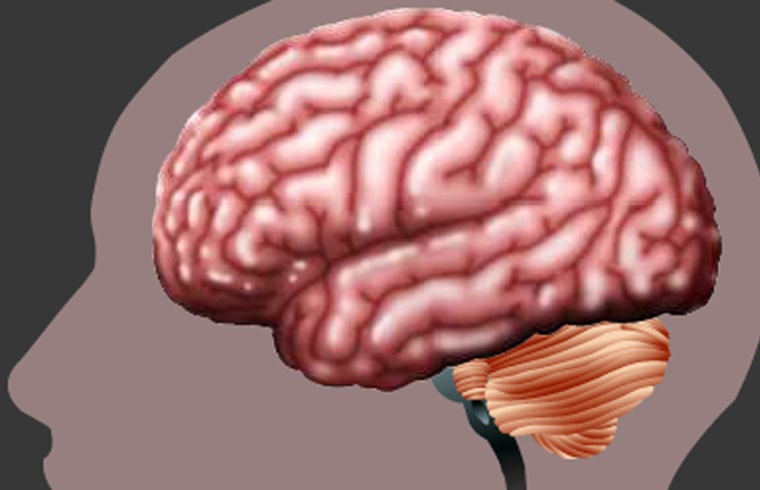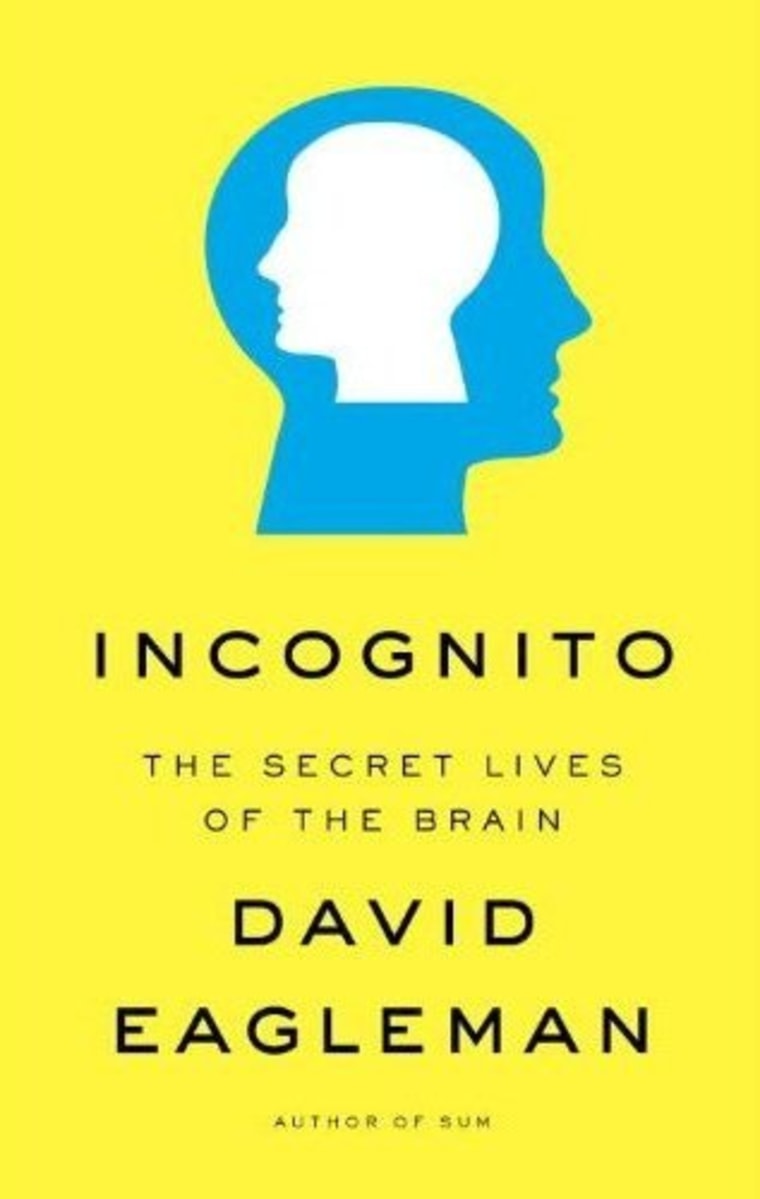
Neuroscientist David Eagleman's latest book, "Incognito: The Secret Lives of the Brain," suggests that our brain's wiring dictates most of what we do, rather than any transcendent self. That goes for crime as well ... which leads him to suggest that the criminal mind is merely an outgrowth of a criminally structured brain.
Does that mean murderers or rapists can beat the rap by pleading that they had no choice but to do evil? Far from it. You are still responsible for your deeds, even if much of what you do happens on an unconscious level. But Eagleman argues that a better understanding of neuroscience should change our approach to crime and punishment, and perhaps even governance in general.
The founding fathers may have declared that all men are created equal, but science shows that all brains are not. And in Eagleman's view, we don't control the brain. The brain controls us ... whatever "us" means.
Eagleman is used to seeing things in a different light: His lab job at the Baylor College of Medicine focuses on how vision works, how our senses overlap each other to create the effect known as synesthesia, and how we perceive time. He's written works on a wide range of deep-think subjects, including "Sum," a series of fables about alternate afterlives.
You could also call Eagleman the prophet of possibilianism, a philosophy that advocates taking an open, inquisitive approach toward cosmic possibilities. "I think it's important, because it represents the scientific temperament: active exploration of different hypotheses without pretending we know what the right answer is in advance," he told me.
"Incognito" delves into the weird workings of our brain, including lighthearted explanations for visual and perceptual illusions (which are another of Eagleman's interests). But it's Eagleman's heavyweight discussion of neuroscience's social and philosophical implications that has attracted the most attention — and elevates "Incognito" above the usual gee-whiz fare.
That was the focus of my recent telephone interview with the author. Here's an edited transcript of the Q&A:
Cosmic Log: Do people really need to think of themselves and their brains in a different way? Or is this just a case of understanding what’s really going on all the time, and we shouldn’t change our lives because of what we read in "Incognito"?
David Eagleman: Well, I don’t know if people will change their lives, but I think that throughout history, there’s been a goal to know ourselves better, and I feel like in some sense, we are at a point in our history where we can understand ourselves at a much deeper level than we were able to previously, because now we’re looking inside the skull, at this alien totally foreign computational fabric that we call the brain, and it is … us. We can understand ourselves so much better by looking at the operations that are running under the hood, most of which have been inaccessible to us.
Q: Some people talk about the view that we have a "zombie brain," the unconscious part of the brain that takes care of everything that's done when you drive home along a familiar route, for example. A lot of the activity that we undertake day to day really is part of that zombie brain. Does that get us in trouble, to have so much going on in our brain that's below the level of consciousness?
A: I don't think it gets us in trouble so much as that it is the thing that "drives the boat." Almost everything that we think and do, act and believe is generated by these systems under the hood that we don’t have access to — whether it’s lifting a cup of coffee to your lips, or recognizing someone’s face, or falling in love.

I wouldn’t say these systems get us in trouble. Your conscious mind, the part of you that switches on the light when you get up in the morning — that is the smallest bit of what’s happening in the brain. The analogy that I use is that the conscious mind is like a stowaway on a transatlantic steamship who is taking credit for the journey without acknowledging the massive engineering underfoot.
Q: One of the themes that comes out in the book is the idea about "who’s really to blame" for bad behavior. If there’s a criminal mind out there, it’s really more the brain’s fault, under the hood, than it is the conscious mind’s fault. What kind of reaction have you been getting to that idea?
A: The whole last half of the book is about what all this means for social policy. I argue that blameworthiness is the wrong question to ask. Brain development is the result of genes, and environment, and their very complicated interaction with one another. The important point is that you don’t choose your genes, and you don’t choose your childhood environment. And so for the kind of brain that you have in the end, it doesn’t really make sense to blame people or credit people, just as you wouldn’t take credit for having color vision or blame for having colorblindness.
The end result is that we have a big variety of brains in our culture. In the book, I say that brains are like fingerprints: They aren’t the same from person to person. So what we have in society is some numbers of people who are breaking laws. The issue really isn’t blameworthiness. It’s not a useful concept. That doesn’t forgive anybody. It doesn’t mean we’ll be putting criminals on the street. What it does mean is that with a biologically compatible system of jurisprudence, we could do customized sentencing, and customized rehabilitation, instead of turning to incarceration as a one-size-fits-all solution.
Q: So would someone with a brain that really isn’t suited to society get a break out of this?
A: Nobody "gets a break." A rabid dog doesn’t get a break. It’s not the rabid dog’s fault that it’s rabid, but we don’t give it a break as a result of that. It’s the same thing with crime. But as we get a better understanding of the brain and behavior, that allows us to predicate sentencing on rational factors — for example, the probability of recidivism. Some people are really dangerous, some people are rabid dogs, and some people aren't. Right now we treat all these things equally, but we need to understand what’s different about different brains.
The other thing we should do is understand better what happens in rehabilitation. Lots of people in prison undergo behavioral changes because they have something wrong with their brain. We’ve never even measured that stuff. The main issue that our prison system has become our de facto mental health care system. Thirty percent of our incarcerated population has mental illness. This is not only inhumane, but it’s not cost-effective. It’s criminogenic, which means it causes more crime. When you put people in prison, they end up going back to prison, because you’ve broken their social circle and limited their employment opportunities.
Q: Does neuroscience suggest that the solution is to warehouse people who are those "rabid dogs" of society? Are there particular therapies or strategies that are suggested for dealing with bad behavior?
A: Yeah, the idea is that wherever we can bring rehabilitative strategies to the table, we should be doing that. Sometimes you can't — for example, with people who are psychopaths. There is no rehabilitative strategy for psychopathy at the moment, so unfortunately, we just have to warehouse them if they’ve proven themselves to be violent criminals. Right now that’s our last resort. But in cases where we are able to help people, that’s what we should be doing.
Q: We should talk about the fun side of the book as well. You bring up some experiments that illustrate how weird our perceptive capabilities can be. In one experiment, a person started asking someone for directions, and while workers carried a door between the two people, a completely different person took the place of the questioner. And yet the direction-giver resumed giving directions without missing a beat, as if nothing had changed. Are there any mental exercises folks can do at home to discover the weirdness in themselves?
A: Well, all vision is an illusion, for example. It’s a construction in the brain. The brain is ensconced in darkness and silence in the vault of your skull. And yet you think you see light. Inside, internally, it’s all electrical and chemical signals. The book is full of visual illusions that demonstrate this sort of thing.
Q: Are there any other themes you want to emphasize from the book?
A: One of the frameworks that I synthesize in the book that’s really important is the fact that you are not one thing. The only way to understand the brain is as a neural parliament, where you have different political parties battling it out to control your behavior. This can now be measured in the brain with neural imaging. We can see that there are all these competing subpopulations in the brain that are always battling it out. You can call this a "team of rivals," and I think that’s a much more nuanced view of ourselves. You can get a real understanding how it is you can argue with yourself and cajole yourself. When you stop to think about it, you might ask yourself, which "you" is you? It’s all you.
I think this gives us a much more nuanced view of others' behavior as well. We don’t have to fall into this simplistic path of asking, "What are this person’s true colors? Is this person a racist or not a racist?" For better or worse, it’s perfectly possible that there are racist parts of your brain and non-racist parts. You get a much better understanding when you understand that, as Walt Whitman correctly surmised, "I am large, I contain multitudes."
He had the spirit of that exactly right. Freud had a similar idea with the concepts of id, ego and superego. What’s different now is that we can actually measure and understand the processes going on under the hood.
More about the brain:
- Interactive: Road map to the brain
- Neuroscientists refveal magicians' secrets
- 3-D images reveal how brain loses consciousness
- Identity crisis: You barely know yourself
- Decoding the secrets of your brain
- Gallery: Ten mysteries of the mind
- Still more about the brain from Cosmic Log
To learn more about Eagleman's life and work, check out this profile from The New Yorker and this video clip from "The Colbert Report."
Connect with the Cosmic Log community by "liking" the log's Facebook page or following @b0yle on Twitter. You can also add me to your Google+ circle, and check out "The Case for Pluto," my book about the controversial dwarf planet and the search for new worlds.
